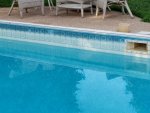Hi. looking for clarification on the water level when closing... First time closing myself (I had previous owner's pool company close last yr as it was first yr with a pool).
I distinctly recall them telling me that they didn't lower the water to below the return jets as mine were installed lower than normal and doing so would reduce the water level too low. You can just see the one jet below water line in left of the pic.
My system has a main drain going into the strainer and a single line from the strainer to the pump and a single return line to the pool to 2 returns jets. I still have about 4" of water in strainer.

Now the question; In pool school, it indicates that I should lower the water level to 4" below returns; however the pool company that's been servicing this pool for the last 20yrs suggested otherwise as I indicated above.... If I drop the water another 5" it will be just below the return jets, but their caution was too low water will cause liner issues in the spring (not enough water to support liner over winter)... I'm in Toronto, Canada and we can get some nasty winters up here. I'm running a SWG system; not sure if that makes a difference (not that I can imagine, but unsure).
Any advice? Pool closing obviously started and hoping to finish today... Any thoughts or suggestions?
Great forum; love the advice provided... Thanks in advance!
I distinctly recall them telling me that they didn't lower the water to below the return jets as mine were installed lower than normal and doing so would reduce the water level too low. You can just see the one jet below water line in left of the pic.
My system has a main drain going into the strainer and a single line from the strainer to the pump and a single return line to the pool to 2 returns jets. I still have about 4" of water in strainer.

Now the question; In pool school, it indicates that I should lower the water level to 4" below returns; however the pool company that's been servicing this pool for the last 20yrs suggested otherwise as I indicated above.... If I drop the water another 5" it will be just below the return jets, but their caution was too low water will cause liner issues in the spring (not enough water to support liner over winter)... I'm in Toronto, Canada and we can get some nasty winters up here. I'm running a SWG system; not sure if that makes a difference (not that I can imagine, but unsure).
Any advice? Pool closing obviously started and hoping to finish today... Any thoughts or suggestions?
Great forum; love the advice provided... Thanks in advance!

